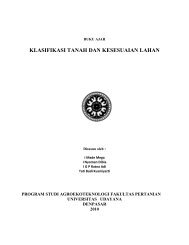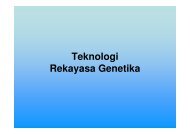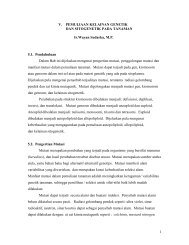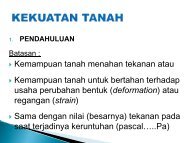Robust CTAB-activated charcoal protocol for plant DNA extraction
Robust CTAB-activated charcoal protocol for plant DNA extraction
Robust CTAB-activated charcoal protocol for plant DNA extraction
Create successful ePaper yourself
Turn your PDF publications into a flip-book with our unique Google optimized e-Paper software.
KRIŽMAN, M. et al: <strong>Robust</strong> <strong>CTAB</strong>-<strong>activated</strong> <strong>charcoal</strong> <strong>protocol</strong> <strong>for</strong> <strong>plant</strong> <strong>DNA</strong>… 429<br />
2 MATERIALS AND METHODS<br />
2.1 Plant material<br />
Fennel leaves and fruits were collected during the flowering period (July 2005) and the<br />
ripening period (October 2005), respectively, in Slovene Istria region. Oregano leaves were<br />
obtained from the experimental fields (yield 2005) of Biotechnical Faculty, University of<br />
Ljubljana (Slovenia). Dried hop cones were obtained from the experimental fields (yield 2005)<br />
of Institute of Hop Research and Brewing Žalec (Slovenia). Hemp seeds were from a<br />
commercial lot of Hungarian cultivar Unico. Samples of coffee beans were kindly donated by<br />
Dr. Furio Suggi Liverani and Dr. Lorenzo Del Terra from Illycaffè S.p.A., Triest, Italy.<br />
2.2 Reagents and chemicals<br />
• Extraction buffer: 100 mM Tris-HCl (pH 8), 2.0 M NaCl, 20 mM EDTA (pH 8), 2 % (w/v)<br />
<strong>CTAB</strong>, 1 % (w/v) PVP (PVP K10, MW 10.000). Be<strong>for</strong>e use, suspend 0.5 % (w/v) of<br />
<strong>activated</strong> <strong>charcoal</strong> in the <strong>extraction</strong> buffer and use it within 3 days. Agitate the suspension<br />
be<strong>for</strong>e pipetting.<br />
• Chloro<strong>for</strong>m-isoamylalcohol: 4% (v/v) isoamylalcohol in chloro<strong>for</strong>m<br />
• Wash solution: 15 mM ammonium acetate in 75 % (v/v) ethanol<br />
• TE buffer: 10 mM Tris-HCl (pH 8), 1 mM EDTA (pH 8)<br />
• Isopropanol<br />
2.3 <strong>DNA</strong> <strong>extraction</strong> <strong>protocol</strong><br />
• Finely homogenize 5 mg to 50 mg of <strong>plant</strong> tissue (depending on the species, the tissue<br />
and its maturity) in a mortar with 1.5 mL of <strong>extraction</strong> buffer. Transfer the mixture into a<br />
microcentrifuge tube. When expecting low <strong>DNA</strong> yields, increase the sample amount, but<br />
proportionally increase the volume of <strong>extraction</strong> buffer as well. Incubate the mixture at<br />
55 °C <strong>for</strong> 30 min with frequent agitation, avoiding the suspension to settle. Cool down to<br />
room temperature.<br />
Note: Avoid tissue freeze-grinding, milling or another type of homogenization be<strong>for</strong>e<br />
adding the <strong>extraction</strong> buffer, since it increases the chances of <strong>DNA</strong> contamination, unless<br />
the tissue is physically though and with a low amount of water (e.g. seeds, beans etc.).<br />
When dealing with though tissues (e.g. coffee beans), it is advisable to presoak the<br />
ground tissue (only the finest fraction) in the <strong>extraction</strong> buffer <strong>for</strong> 2 hours at room<br />
temperature be<strong>for</strong>e <strong>extraction</strong> and avoiding further homogenization with the <strong>extraction</strong><br />
buffer in a mortar.<br />
• Centrifuge at 16000 g <strong>for</strong> 10 min at room temperature. Transfer the supernatant to a new<br />
tube.<br />
• Add 1 volume of chloro<strong>for</strong>m-isoamylalcohol to the supernatant and vortex thoroughly.<br />
Centrifuge at 16000 g <strong>for</strong> 10 min at room temperature. Transfer the aqueous (upper)<br />
phase to a new tube. Repeat the chloro<strong>for</strong>m-isoamylalcohol <strong>extraction</strong> once or more, if<br />
cloudiness in the solution persists.<br />
• Transfer the supernatant to a new tube, add 0.45 volume of isopropanol and mix by<br />
inversion. Incubate at 25 °C <strong>for</strong> 1 hour. Centrifuge at 700 g <strong>for</strong> 10 min at room<br />
temperature.<br />
• Discard the supernatant. Wash the pellet by adding 1 mL of wash buffer and vortex.<br />
Centrifuge at 900 g <strong>for</strong> 10 min at room temperature.<br />
• Discard the supernatant and air dry the pellet at room temperature, but do not overdry.<br />
• Dissolve the pellet in 25 µL of TE buffer. If there are some impurities left, centrifuge at<br />
16000 g <strong>for</strong> 10 min at room temperature and transfer the supernatant to a new tube.<br />
Store the <strong>DNA</strong> solution at 4 °C <strong>for</strong> short-term or at –20 °C <strong>for</strong> long-term storage. If<br />
needed, treat the <strong>DNA</strong> solution with RNase be<strong>for</strong>e use.<br />
3 RESULTS AND DISCUSSION<br />
The extracted <strong>DNA</strong> was quantified by a fluorometric assay using a Hoefer DyNA<br />
Quant 200 fluorometer and a <strong>DNA</strong>-specific dye, Hoechst H33258 (Hoefer, San









